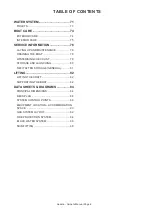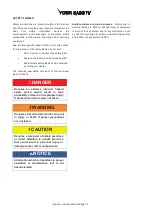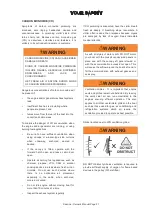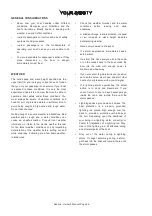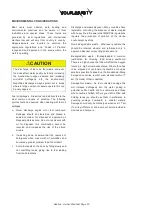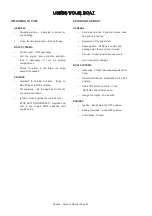
<2856$)(7<
6HDOLQH2ZQHUV0DQXDO3DJH
STABILITY
Your boat is manufactured to specific stability and
flotation standards for the capacity shown on the
certification
plate.
Any
increase
from
the
recommended load capacities will put your boat in
jeopardy of capsizing, swamping and/or sinking, the
following may cause the stability and buoyancy to be
compromised:
ವ
Stability may be substantially reduced if
equipment is added above the deck.
ವ
Stability is substantially reduced by loose
fluids or weight within the hull. Keep bilge
area as dry as possible, and close all
openings, hatches and windows in rough
weather.
ವ
Any change in the disposition of the masses
aboard (eg the addition of radar, stowing
mast, change of engine) may affect stability,
trim and performance of the craft.
ವ
In rough weather, hatches, lockers and
doorways should be closed to minimize the
risk of flooding.
ವ
Stability may be reduced when towing or
lifting heavy weights using the crane/
passerelle.
ವ
Breaking waves are a serious stability
hazard.
Handling in heavy weather - Always pay attention
to the prevailing weather conditions and reduce
speed
accordingly,
as
dictated
by
good
seamanship and common sense. You should
always adjust your course and speed to avoid the
hull slamming off the back of waves.
CHART YOUR COURSE
To avoid boating in unsafe areas where there are
underwater obstructions, shallow water, unnavigable
conditions such as dangerous currents, and others,
you must chart a course.
This means having the relevant and up to date charts
for coastal waters, observing and understanding all
navigational aids, using the knowledge and guidance
of experienced boaters, and being aware of the tide
times where appropriate.
If you are in an unfamiliar area without knowledge of
the hazards, proceed very slowly and have someone
watch for hazards.
Let others know where you are going. A passage
plan describes your intended cruising course and
itinerary, boat description, and your expected time
and date of return. Give the passage plan to a friend
or relative, so they can give the information to a
national boat agency, like the Coast Guard, in the
event you fail to return.
INTERNATIONAL REQUIREMENTS
In some countries, a driving licence or authorisation
is required, or specific regulations are in force.
The crew should be familiar with the use of all safety
equipment. This equipment is mandatory in most
countries.
Summary of Contents for S450
Page 1: ... ...
Page 2: ... ...
Page 6: ... 6HDOLQH 2ZQHU V 0DQXDO 3DJH ...
Page 55: ... 75 6HDOLQH 2ZQHU V 0DQXDO 3DJH AC PANEL 10 10 16 10 16 16 16 16 16 10 16 10 ...
Page 81: ... 7 1 6HDOLQH 2ZQHU V 0DQXDO 3DJH ...
Page 82: ... 6HDOLQH 2ZQHU V 0DQXDO 3DJH DATA SHEETS DIAGRAMS PRINCIPAL DIMENSIONS ...
Page 84: ... 6HDOLQH 2ZQHU V 0DQXDO 3DJH DECK PLAN ...
Page 86: ... 6HDOLQH 2ZQHU V 0DQXDO 3DJH SYSTEM CONTROL POINTS ...
Page 88: ... 6HDOLQH 2ZQHU V 0DQXDO 3DJH EQUIPMENT LOCATION ACCOMMODATION SPACE ...
Page 90: ... 6HDOLQH 2ZQHU V 0DQXDO 3DJH GAS SYSTEM LAYOUT ...
Page 92: ... 6HDOLQH 2ZQHU V 0DQXDO 3DJH FIRE PROTECTION SYSTEM 3 4 1 5 6 8 1 2 7 8 8 1 ...
Page 94: ... 6HDOLQH 2ZQHU V 0DQXDO 3DJH BLACK WATER SYSTEM ...


